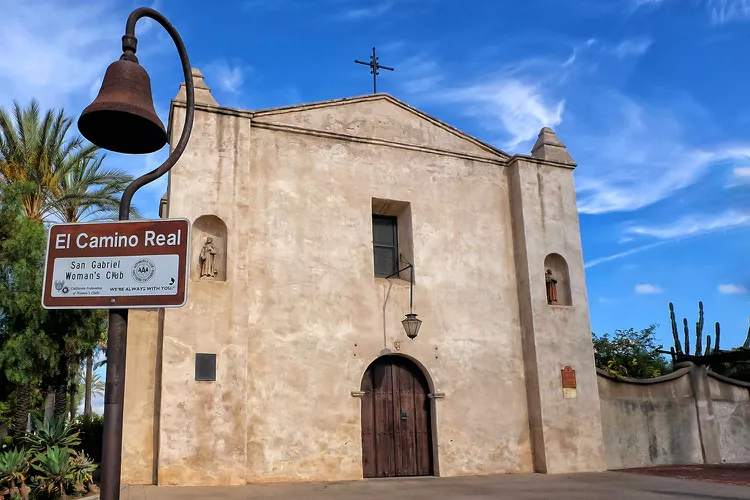Overview of San Gabriel Mission
San Gabriel Mission was the fourth mission established in California. Founded on September 8, 1771, by Fathers Pedro Cambon and Angel Somera, it is named after the Archangel Gabriel.
Interesting Facts about San Gabriel Mission
Mission San Gabriel is notable for being the oldest structure of its kind south of Monterey. Interestingly, settlers from this mission were essential in establishing the City of Los Angeles. Moreover, it stands as the only mission in California featuring Moorish architecture and lacks a bell tower.
Location of San Gabriel Mission
Mission San Gabriel is situated at 428 South Mission Drive in San Gabriel, CA. For further details about visiting hours and directions, refer to the Mission San Gabriel Website.
History of San Gabriel Mission: 1771 to Present Day
In 1771, only two Spanish missions existed in what is now California: one in San Diego and another in Carmel, separated by over 400 miles. However, as more Franciscan missionaries arrived, Father Serra decided to build additional missions between these two locations.
They founded the San Gabriel Mission as the fourth in a chain of 21 missions. The original plan placed the mission on the Santa Ana River, but instead, it was built along the San Gabriel River.
Legend has it that native chiefs attempted to stop the construction of the mission, fearing conflict. However, when shown a painting of the Virgin Mary as Our Lady of Sorrows, the indigenous people laid down their weapons, allowing the mission to be built.
Early Years
The Tongva Indians inhabited the region of California, specifically around modern-day Los Angeles, for 7,000 years before the arrival of the Spanish. They established permanent villages along streams and rivers, crafting homes called “Kiiy” from willow branches and reeds.
Initially, the Tongva welcomed the Spanish missionaries, assisting in building the mission. However, relations deteriorated due to conflict with soldiers, leading to tragic incidents, including the death of a chief’s husband.
In 1774, the Spanish explorer Juan Bautista de Anza established a land route that enhanced San Gabriel Mission’s importance. Subsequently, in 1775, the fathers moved the mission to a more suitable site closer to the mountains.
By 1781, several families and indigenous people left San Gabriel Mission to found what is now Los Angeles.
San Gabriel Mission in the 1800s
Fathers Sanchez and Cruzado took over the mission in 1776, leading to further developments including church construction that began in 1779. After their deaths in 1805, Father Jose Zalvidea managed the mission for the next two decades.
Secularization
Following Mexico’s independence from Spain, missions were secularized, with land intended for native peoples. Unfortunately, much of the land ended up with untrustworthy politicians, prompting the mission’s oversight to be transferred to a civil administrator in 1834.
San Gabriel Mission in the 20th Century
Throughout the 20th century, San Gabriel Mission functioned as a parish church until reconstruction began in 1908 under the Claretan Fathers. After sustaining damage from the 1987 Whittier earthquake, ongoing restoration efforts were initiated.
San Gabriel Mission Layout, Floor Plan, Buildings, and Grounds
Designed by Father Antonio Cruzado, San Gabriel Mission is distinct for its Moorish architectural style. Unlike the adobe constructions of other missions, it utilized stone, brick, and mortar, taking 26 years to complete building the church.
The church features a length of 150 feet, width of 27 feet, and walls that rise to 30 feet high. Notably, an earthquake in 1812 destroyed the original bell tower, which was later replaced by a bell wall holding six ancient bells.
San Gabriel Mission Exterior
Notable features include an entrance that deviates from traditional mission design, which typically places the door on a narrow wall.
San Gabriel Mission Interior
Recognized as one of California’s best-preserved missions, San Gabriel contains many original features. Altar statues, along with a hammered copper baptismal font, reflect its rich history and artistry.
San Gabriel Mission Aqueduct
The mission’s water supply, sourced from Wilson Lake, was ingeniously routed through an open ditch into clay pipes, serving essential areas such as the tannery and kitchen.
San Gabriel Mission Candle and Soap Factory
The candle and soap factory, which used large iron pots over deep furnaces, was significant in supplying soap to various California missions.





